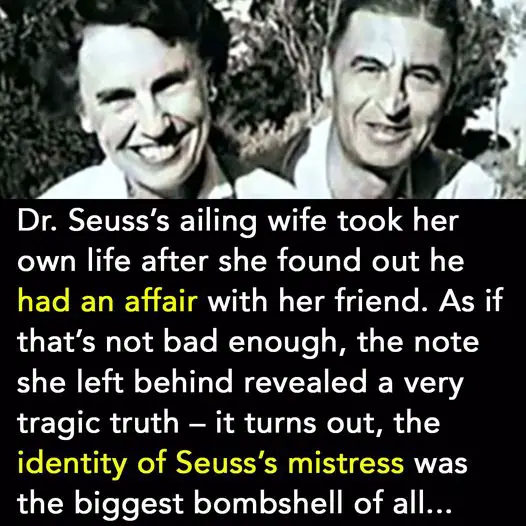Dr. Seuss, the beloved author behind cherished children’s classics like The Cat in the Hat and Green Eggs and Ham, is known worldwide for his whimsical illustrations and poetic flair. However, few are aware of the dark and complex personal life of Theodor Geisel, the man behind the pseudonym. This shadowy chapter includes infidelity, personal turmoil, and suicide, offering a stark contrast to the joyful stories he created.
Geisel’s personal life was marked by his two marriages. His first wife, Helen Palmer, played a significant role in shaping his career. The couple met while studying at Oxford University, where Helen quickly recognized Geisel’s creative potential and encouraged him to pursue a career as an illustrator rather than his initial goal of becoming an English professor. “Ted’s notebooks were always filled with these fabulous animals,” Helen recalled later, pushing him toward the creative world he would later dominate.
Despite their strong partnership, the Geisels faced numerous challenges, particularly financial struggles during the Great Depression. Helen couldn’t have children due to health complications, but she remained an unwavering supporter of her husband’s work, helping him rise to prominence.
Helen was not just a supportive wife; she played a critical role in Dr. Seuss’s career. She co-wrote Design for Death, a documentary that won an Academy Award in 1947, and also co-founded the “Beginner Books” imprint in 1957, which helped launch some of Seuss’s most famous works. However, Helen’s contributions often went uncredited.
Unfortunately, Helen’s health deteriorated over the years. She developed Guillain-Barré Syndrome, a painful and debilitating condition that resulted in partial paralysis. While Helen struggled with her illness, Geisel found solace elsewhere, engaging in an affair with family friend Audrey Stone Dimond.
Helen’s physical pain was compounded by emotional suffering. Depressed and likely aware of her husband’s infidelity, she tragically took her own life on October 23, 1967. Her suicide note, addressed to her husband, read, “Dear Ted, What has happened to us? I don’t know… I love you so much… I am too old and enmeshed in everything you do, and I cannot conceive of life without you.” Her words paint a heartbreaking picture of a woman who felt trapped and devastated by the disintegration of her marriage.
Geisel’s grief following Helen’s death was profound. “I didn’t know whether to kill myself, burn the house down, or just disappear and get lost,” he said. However, less than a year after Helen’s death, Geisel married Audrey, a woman 18 years his junior. Their relationship sparked controversy, given the proximity of their union to Helen’s suicide and Audrey’s previous marriage.
Audrey had to navigate not only the legacy of her predecessor but also her own sacrifices. She sent her daughters away to school, explaining that they would not have fit into Geisel’s life. However, Audrey, like Helen, became deeply involved in Geisel’s work, and his writing took on a new direction under her influence. She reflected, “I created the beard. He had a nose that was looking for a beard all his life.”
Despite his personal turmoil, Geisel’s legacy continued to flourish. However, the dark chapter of his life with Helen still casts a shadow over his achievements. This complexity in his personal life reveals a man who, like many, struggled with the pressures and responsibilities of relationships, career, and personal demons.
Geisel passed away on September 24, 1991, at 87 years old. His ashes were scattered in the Pacific Ocean, and although his creative work continues to inspire generations, the complexities of his personal life remind us that even the most brilliant minds can grapple with profound darkness.
Through Helen’s tragic end and Audrey’s dedicated support, Dr. Seuss’s story becomes much more than the whimsical, joyful tales he penned. His personal life, filled with heartache, loss, and new beginnings, adds layers to the man behind the legendary stories. While Dr. Seuss’s books are beloved worldwide, understanding the emotional complexities that shaped his work provides a deeper connection to the author’s true life journey.
Conclusion
Dr. Seuss remains one of the most celebrated authors in history, but his personal life reveals the complexity behind the joyful tales. His relationships with his two wives, their sacrifices, and the tragedies they endured paint a fuller picture of the man behind the famous pseudonym. His story, like many of his books, teaches us that life is often a balance of light and dark.

